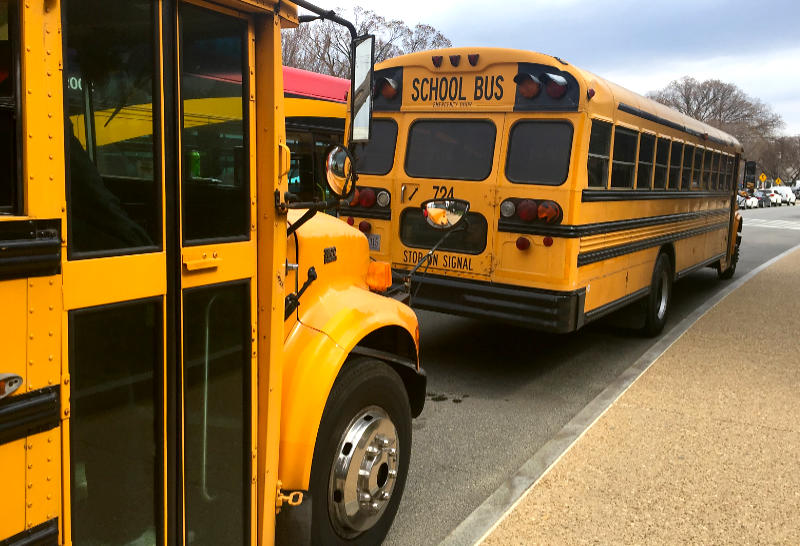
Photo: Jean Woloszczyk/Unsplash
Family Features - Another school year means millions of children across the United States will begin and end each day with a bus ride. The way many kids ride to school today, however, is the same as it was 25 years ago - in diesel school buses, which have been shown to be harmful to children's health, the community and the climate.
Investments are being made to clean up the nation's school bus fleet, like the Environmental Protection Agency's (EPA) Clean School Bus Program, which will provide $5 billion over five years to help replace existing buses with low- and zero-emission models. One alternative energy source, propane, is an environmentally friendly and affordable option that can be implemented today to provide a better tomorrow for more students. The low-carbon emissions energy source is abundantly available and can work in tandem with other energy sources, including electric, to move the nation's school bus fleet further down the path to zero emissions and ensure every child has a safe, clean, healthy ride to school.
In addition to speaking to your children's school district officials about alternative school bus solutions, there are lessons parents can teach their children about how to remain safe before, during and after their daily trips on school buses. Consider these tips from the experts at the National Association of Pupil Transportation.
Before the Bus Arrives
Ensure backpacks are packed securely so papers and other items don't scatter as the bus approaches.
Create a morning routine that puts kids at the bus stop five minutes before the scheduled pickup time. This helps avoid a last-minute rush, when safety lessons are easily forgotten, and ensures kids are safely in place for boarding.
Encourage children to wear bright, contrasting colors so they can be seen easier by drivers.
Instruct children to walk on the sidewalk. If there is no sidewalk, advise them to stay out of the street, walk single-file, face traffic and stay as close to the edge of the road as possible.
Walk young children to the bus stop or encourage kids to walk in groups. There is safety in numbers; groups are easier for drivers to see.
If kids must cross a street, driveway or alley, remind them to stop and look both ways before crossing.
Verify the bus stop location offers good visibility for the bus driver; if changes are needed, talk with nearby homeowners or school district officials to implement changes. Never let kids wait in a house or car, where the driver may miss seeing them approach the bus.
Remind children the bus stop is not a playground. Balls or other toys can roll into the street and horseplay could result in someone falling into the path of oncoming traffic.
Instruct children to stay at least three steps away from the road and allow the bus to come to a complete stop before approaching it.
On the Bus Ride
When boarding the bus, items can get bumped and dropped. Caution children that before picking anything up, they should talk to the driver and follow instructions to safely retrieve their possessions.
Teach safe riding habits: Stay seated with head, hands and feet inside at all times; keep bags and books out of the aisle and remain seated until the bus stops moving.
Instruct children to never throw things on the bus or out the windows and to never play with or block emergency exits.
Remind kids that loud noises are off limits so they don't distract the driver. That includes cellphones and other electronic devices; instruct children to put them on mute or use headphones.
Leaving the Bus
Remind children to look before stepping off the bus. If they must cross the street, teach them to do so in front of the bus by taking five big steps (approximately 10 feet) away from the front of the bus, looking up and waiting for the driver to signal it's safe.
For parents who meet their kids at the bus, eliminate the risk of your children darting across the street by waiting on the side of the street where they exit the bus.
Make the bus ride part of your daily "how was school?" discussion. Encourage kids to talk about the things they see and hear on the bus so you can discuss appropriate behaviors and, if necessary, report any concerns to school administrators.
Benefits of Propane Buses
Every day, 1.3 million children in the United States ride to school in 22,000 propane-powered school buses, which are currently in use by more than 1,000 school districts across 48 states. Alternative fuels, such as propane, offer multiple benefits for school districts and students alike because propane buses reduce harmful emissions, save money and provide a safer ride for students. Student Health
Propane reduces harmful nitrogen oxide emissions by up to 94% compared to diesel and emits near-zero particulate matter emissions. Both emissions, which can be found in the cloud of smoke emitted from the tailpipes of diesel buses, are known triggers for asthma, bronchitis and other respiratory problems, according to the EPA. Reliability
Propane has a range of 400 miles and the performance needed to drive long distances without stopping to recharge or refuel. Cost Savings
While propane and electric are both options for clean student transportation that also reduce the harm to air quality, the cost is not equal. On average, an electric school bus costs $375,000, meaning districts can purchase three propane-powered buses (which are only $6,000 more expensive than diesel buses) for the price of one electric bus. In fact, a study from the World LP Gas Association found the cost savings of getting rid of all diesel buses and replacing them with propane would save enough money to hire 23,000 teachers due to lower long-term fuel and maintenance costs. Find more information and learn how to talk to school district officials about adopting clean school buses at BetterOurBuses.com.
Every day, 1.3 million children in the United States ride to school in 22,000 propane-powered school buses, which are currently in use by more than 1,000 school districts across 48 states. Alternative fuels, such as propane, offer multiple benefits for school districts and students alike because propane buses reduce harmful emissions, save money and provide a safer ride for students. Student Health
Propane reduces harmful nitrogen oxide emissions by up to 94% compared to diesel and emits near-zero particulate matter emissions. Both emissions, which can be found in the cloud of smoke emitted from the tailpipes of diesel buses, are known triggers for asthma, bronchitis and other respiratory problems, according to the EPA. Reliability
Propane has a range of 400 miles and the performance needed to drive long distances without stopping to recharge or refuel. Cost Savings
While propane and electric are both options for clean student transportation that also reduce the harm to air quality, the cost is not equal. On average, an electric school bus costs $375,000, meaning districts can purchase three propane-powered buses (which are only $6,000 more expensive than diesel buses) for the price of one electric bus. In fact, a study from the World LP Gas Association found the cost savings of getting rid of all diesel buses and replacing them with propane would save enough money to hire 23,000 teachers due to lower long-term fuel and maintenance costs. Find more information and learn how to talk to school district officials about adopting clean school buses at BetterOurBuses.com.







